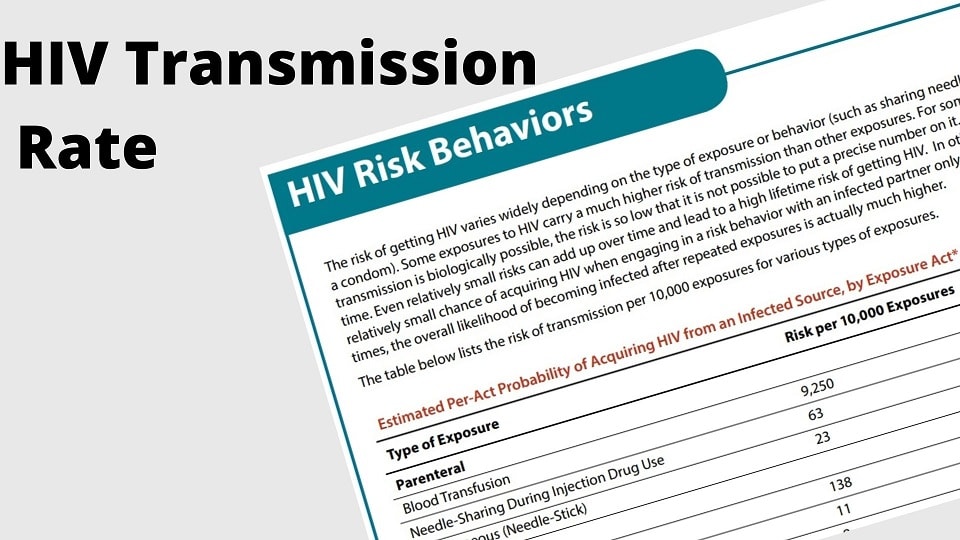
As we have known about HIV for many decades now, it is the HIV virus that can cause a state of failure in your immune system, known as immune deficiency state which is referred to as AIDS. This is generally the late stage of untreated HIV infection.
HIV transmission medium
Some of the common ways HIV enters our blood stream (our body or our system) are due to the contact with 3 different types of body fluid and they are as follows.
- Contact with the blood of the infected person.
- Contact with the genital or sexual fluid of the infected person.
- Through breast milk (usually from infected mother her child)
Please note that the above mentioned infected body fluid needs to come in contact with the broken skin or directly with your bloodstream (through needles, infections etc) in order for the HIV virus to transmit.
OR
There is a transmission of HIV if the above mentioned body fluid comes in contact with the mucous membrane of the recipient (non infected person). Mucous membranes are the parts of the body which are protected by the normal skin example: inside of the mouth, inside of the vagina or rectum or at the opening of the penis etc.
Definition of Mucous membrane: Mucous membrane is the moist, inner lining of some organs and body cavities (such as the nose, mouth, vagina, anus, penis).
So, in short, the above mentioned fluids of the infected person has to enter your bloodstream through direct contact (needle) or through mucous membrane for the HIV transmission to happen.
Common HIV transmission scenarios and their rate of transmission
There are fairly 4 common scenarios due to which the HIV transmission occurs from person to person. These are the most common situations that HIV is spread via the group of fluids mentioned above (blood, genital fluid, breast milk) and they are as follows.
Scenario 1: Spread of HIV due to contact with Sexual fluid
This is the situation where the transmission of HIV virus is due to unprotected sex with someone who has HIV infection.
This happens when there is a contact with sexual fluids like semen or pre-seminal fluid or vaginal fluid or even rectal fluid can spread HIV when comes in the contact. This is because there’s often a fairly high amount of viral particles within these fluids. This is particularly within the first few weeks of a new HIV infection, when the infected person’s viral load in their blood or in their sexual fluids is up at extremely high levels.
So below is the data table stating the HIV transmission rate (in percentage) due to contact with sexual fluid to certain types of sexual activities.
Following are the ways in which the sexual fluids can enter the person’s body to transmit HIV virus to a healthy person.
Transmission rate of HIV due to certain types Sexual Activity
Here we have to compare the transmission rate of HIV due by sexual activities such as Vaginal Sex or Anal Sex. The Anal sex has highest risk of transmission and vaginal sex has second highest risk of transmission, lets get into the details of each.
Please note: All the data in the table has been taken from the research work done from the body which is affiliated with the government of US between the time period of 2015 to 2019** (** the latest report till date). Also note: HIV incidence has declined by 8% from 2015 to 2019
a) HIV transmission due to Anal Sex
The sexual behavior where unprotected anal sex by either a men and women is the highest risk sexual behavior. This is because it poses threat of exposure of HIV-infected sexual fluids to mucous membranes (inside of the rectal of a men or a women). The risk is high if there is any trauma to the involved body part there can be some blood as well which may have virus.
So in short, the virus from from infected sexual fluid or blood can get across the mucous membranes of an uninfected person, or it can just get directly into a person’s bloodstream through an area that might be bleeding.
The following table shows the risk of HIV transmission due to Anal Sex
| Type of Exposure | Risk per 10,000 Exposures | Chances in Percentage |
| Receptive Anal Intercourse | 138 | 1.38 |
| Insertive Anal Intercourse | 11 | 0.11 |
b) HIV transmission due to Vaginal Sex
Vaginal Sex is the second highest risk sexual behaviors for HIV transmission.
In vaginal sex there is an exposure of of sexual fluids, right, semen and vaginal fluid to mucous membranes (of vagina), through which HIV virus can hop across and enter into the system (of a healthy person).
| Type of Exposure | Risk per 10,000 Exposures | Chances in Percentage |
| Receptive Penile-Vaginal Intercourse | 8 | 0.08 |
| Insertive Penile-Vaginal Intercourse | 4 | 0.04 |
Again, like in the anal sex, but less likely compared to anal sex. The vaginal sex too can involve transmission of HIV virus to a person through the body parts (parts of vagina/penis) with trauma which may involve blood containing the HIV.
Although anal sex has highest risk of transmission and vaginal sex has second highest risk of transmission, but Vaginal sex is the way HIV has transmitted most frequently, overall. This is because overall more people have vaginal sex over anal sex.
c) HIV Transmission due to Oral Sex
The transmission rate of HIV due to Oral Sex of any kind (oral sex with mouth to stimulate penis or anus) carries a same risk of transmission as that of coming in contact with the sexual fluid.
| Type of Exposure | Risk per 10,000 Exposures | Chances in Percentage |
| Receptive Oral Intercourse | 4 | Low 0.04 |
| Insertive Oral Intercourse | Low | Low |
So, while in oral sex, mucous membranes of the mouth is being exposed to sexual fluids and mucous membranes of the penis or the vagina or the anus being exposed to possibly blood or maybe the person’s mouth had some open sores in it.
Also Read : HIV Tongue: [See Pictures] identify symptoms at every HIV stage
Scenario 2: Transmission rate of HIV due STDs such as Chlamydia, Syphilis or Herpes
Having existing STD or STI such as Chlamydia, Syphilis or Herpes vastly increases the risk of contracting HIV in risky scenarios. During these STDs, you are more likely to have breaks in your skin or mucosal surface from symptoms of these STIs like sores or ulcers, and through these, HIV can more easily infect you.
Following is the table indicating the risk factor of HIV transmission due to STDs
Also read: HIV Non reactive test result meaning
Scenario 3: Transmission rate of HIV due exposure to infected blood.
HIV transfusion during transfer of blood, also known as Contaminated transfusion. Contaminated blood transfusion is not much of a concern these days. With the advent of new healthcare technology and rigorous screening of donor and the supplier’s blood in the lab/blood banks for HIV, the transmission rate of HIV due to faulty or defective transfusion methods is minimal. However, the transmission of HIV can happen from blood through other means such as needles.
| Type of Exposure | Risk per 10,000 Exposures | Chances in Percentage |
| Blood Transfusion | 9,250 | 92.5 |
This mode of transmission involves the procedures involving needles contaminated by someone else’s blood. So Example: Using intravenous (IV) drugs and then sharing needles with an HIV-infected person.
In that case, HIV is just one of the many viruses you might pick up by sharing needles in IV drug use, because you’re essentially transferring tiny droplets of an infected person’s blood directly into your bloodstream on a needle.
Other scenarios of HIV transmission might involve a healthcare professional working with an HIV-positive patient, maybe he is drawing some blood where he might accidentally get stuck by the needle after it’s been contaminated with their blood, and incidents like these unfortunately do occasionally happen. There is a risk of HIV transmission from them.
HIV transmission risk depends to some extent on a person’s viral load. So all the above stated risks can be higher or lower depending on the viral load in the blood. Viral load refers to the amount of virus in an infected person’s blood. This is expressed as the number of viral particles in each milliliter of blood.
Typically, very low amounts of HIV, if they’re being treated with specific medications, and typically pretty high amounts of HIV, if they’re not being treated.
Scenario 4: Transmission rate of HIV during childbirth (from mother to child)
This one is probably the most probable reason for HIV transmission in kids. In fact 90% of around 90% of the HIV that we see in kids is passed on from their mom during their birth,
This type of HIV transmission is also called vertical transmission because it passes from a mother to her baby during gestation or during birth. This transmission is believed to happen as the child is being exposed to mother’s blood or vaginal fluid during the time of birth and the skin of the new born babies are very thin.
Luckily, modern medications given to mothers during the pregnancy & labor makes the chances of HIV transmission very grim.
All of that drastically reduces the risk of mom passing HIV on to her baby, from a risk of about 25 to 30% HIV transmission, without medication, all the way down to only about 1 to 2%, with medications.
Also read: Get tested for HIV with an exclusive, $10 discount coupon now!!
Get tested for HIV with an exclusive, $10 discount coupon now!!
Scenario 5: Transmission rate of HIV from mother to child through breast milk
Breast milk in an infected mom will contain HIV virus. So when the baby feeds, it’ll be ingesting this HIV virus. When the baby ingests it, it can infect the baby by being absorbed through the digestive tract.
Also, the risk of HIV transmission is highest in the early months of breastfeeding
A meta-analysis of 5 studies estimated the HIV transmission risk through breastfeeding to be 14% (95% CI, 7%-22%).
Scenario 6: HIV transmission through small cut
This can be extremely rare, but the very possibility of HIV transmission through contact between broken skin, wounds, or mucous membranes and blood or body fluids from a person who has HIV.
Very small number of documented cases has been observed, involving HIV transmission through severe trauma with extensive tissue damage and the presence of blood. But this is so rare that we can quote that there is no risk of transmission through unbroken skin.
If you are still unsure or if you lie in the category of High risk HIV transmission behavior, it is always better to get tested for HIV.
Here, at STDtestingnearme.org we provide a $10 discount on every test you order.
Scenario 7: HIV transmission in different Demographic groups
The below table shows the HIV transmission risk among people in different demography.
It has been found that the Bisexual and Gay people has the highest risk of newly acquiring the HIV.
The HIV transmission rate was highest for persons aged 25-34 years age group (30.1)
In 2019, the highest HIV transmission rate was for Blacks/African American persons (42.1)
In 2019, the rate for males (21.0) was 5 times the rate for females (4.5).
| Demographic Groups | Percentage of HIV transmission | |
| Sexual Orientation | Bisexual & Gay* | 70% |
| Race/Ethnicity | African American | 42% |
| Age Group | Age group 25 to 34 years | 30% |
| Sexual Orientation | Transgender women who have sex with men | Higher |
| Behavioral group | People who use injected drugs | Higher |
If you are still unsure or if you lie in the category of High risk HIV transmission behavior, it is always better to get tested for HIV.
Here, at STDtestingnearme.org we provide a $10 discount on every test you order.
- * 70% of Bisexual & Gay peoples are observed in newly acquired cases HIV cases.
References
- https://pubmed.ncbi.nlm.nih.gov/24809629/
- https://pubmed.ncbi.nlm.nih.gov/10507789/
- Patel P, Borkowf CB, Brooks JT. Et al. Estimating per-act HIV transmission risk: a systematic review. AIDS. 2014. doi: 10.1097/QAD.0000000000000298.
- Pretty LA, Anderson GS, Sweet DJ. Human bites and the risk of human immunodeficiency virus transmission. Am J Forensic Med Pathol 1999;20(3):232-239
- https://www.cdc.gov/hiv/pdf/risk/estimates/cdc-hiv-risk-behaviors.pdf
- https://www.cdc.gov/hiv/pdf/library/reports/surveillance/cdc-hiv-surveillance-supplemental-report-vol-26-1.pdf (search race)



